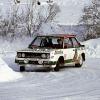F1 Driving vs. Rally Driving
#1

Posted 22 July 2004 - 08:48
Advertisement
#2

Posted 22 July 2004 - 09:37
Rally drivers can't practice the corners of a stage to drive them to perfection like circuit drivers can. Also the grip due to circumstances (weather, temperature, dust etc) is unknown to drivers when they approach a corner. Cuircuit drivers know them from the previous lap.
#3

Posted 22 July 2004 - 09:39
#4

Posted 22 July 2004 - 10:01
Then there is the sporting difference between race and rally. On a WRC round, competitors only get two recce runs through a stage, which are done at a limited speed (50kph). So when they arrive at a corner, it is the FIRST time they have taken it at rally speed – and they will probably only use it once more on that rally. This compromises the driver’s line, as do factors like the road surface, the line of sight, what the next corner is like and so on. Racing is a far more pure form in that you get lots of chances to optimise your line. Rally is a more pragmatic exercise, where sheer speed through one corner is not the only factor. In practice, the best tarmac rally drivers do use racing lines (but being rally drivers, they are also quite happy to cut across the grass massively if this helps their stage times!). And put on a race-track, good rally drivers have historically proved to be competent race drivers as well.
Driving on gravel is a rather different matter. Although transmission developments have noticeably reduced the “sideways” style of old, there is still a tendency to use the traction of the car to counteract the lack of grip from a gravel surface. It was found long ago that a tyre scrubbing sideways across gravel provided more deceleration than conventional straightline braking. The “Scandinavian flick” meant that as you approached, say a right hand corner, you would put the car sideways towards the left under braking, then, when you released the brakes, the car would tend to turn sharply right. You would then stand on the throttle and take the corner under power, using opposite lock on the steering. This meant that you were hard on the power even BEFORE the apex of the corner. Modern 4WD WRCs still retain some element of this style, albeit a shadow of the old RWD cars, because it remains the quickest way through a corner on gravel.
Rally and Race are not the same, and long may it remain so!
#5

Posted 22 July 2004 - 13:08
#6

Posted 23 July 2004 - 05:17
#7

Posted 26 July 2004 - 20:06
#8

Posted 27 July 2004 - 12:08
rally cars are also pretty heavy and subjected to heavy understeer so a good handbrake technique is important to make the car turn quickly so power can be applied again, both to accelerate and to control the car.
however, even at high level (WRC) rallying, watchin an hairpin will show that only a minority of drivers take the hairpins correctly using the handbrake. as someone else pointed out, surface conditions change continuosly. some cars bring gravel on the tarmac making it more slippery. then after 3 or 4 passes it is clean again. it's ahit or miss thing really.
i have seen some drivers on FWD cars also use another technique, which is to take all the understeer possible at full lock and apply as much power as possible. in some cases, its easier and faster than handbrake turn.
on gravel, there is no alternative, because of the understeer. car must be made turn using alternative techniques, like the "pendulum", handbrake etc.
gm
Originally posted by perseus3
I always noticed how wrc drivers, even on tarmac, will let the rear of the car come round on tight turns, as opposed to the "on rails" style of F1 driving. I was wondering if rally drivers would be faster if they took turns like F1 and used apexes? I assume each method works the best for each series, but what is it in the physics that makes each technique faster for their respective cars?
#9

Posted 27 July 2004 - 12:10
gm
#10

Posted 31 July 2004 - 15:51
#11

Posted 31 July 2004 - 17:06
#12

Posted 04 August 2004 - 17:22
I remember Tommy Makkinen testing the Veltin Williams WoodyWoodpecker and he just spun accelerating out of the corner - so violently as I've never seen an open-wheel driver doing that (except Greeg Moore on his death) - and hit the wall in the inside line.
I think Massa would become an excellent Rally driver as he likes to shake his arms and is very darring.
#13

Posted 05 August 2004 - 07:30
He just downshifted when he should upshift, messed the paddles...Originally posted by FuscaBala
I remember Tommy Makkinen testing the Veltin Williams WoodyWoodpecker and he just spun accelerating out of the corner - so violently as I've never seen an open-wheel driver doing that (except Greeg Moore on his death) - and hit the wall in the inside line.














